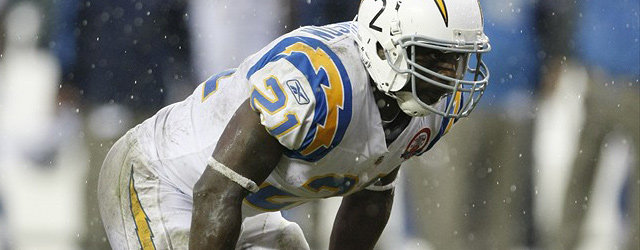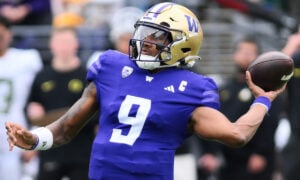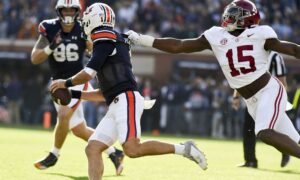Mining the Past – A Decade of Top RB Performances
What can the recent past performance of top running backs tell us? Is there any specific type of player who tends to get overlooked? Are certain types of players overrated? I pulled together a list of the top twenty running backs for the past ten seasons (2002–2011) using Footballguys.com rankings to see if we can tease any information out of those performances.
This research netted me 80 running backs varying from LaDanian Tomlinson (clearly the best back of the past decade for fantasy) to Chris Brown (ranked #20 in 2005). Giving twenty points for a #1 ranked season down to 1 point for #20 ranked season give you a sense of the stars of the past decade. To wit, the top ten are LaDanian Tomlinson, Clinton Portis, Adrian Peterson, Maurice Jones-Drew, Shaun Alexander, Steven Jackson, Tiki Barber, Frank Gore, Brian Westbrook and Edgerrin James (note: Edge, Alexander, Barber and LT all had some points from before 2001, as did several other prominent stars from the first half of the decade, which I’ll consider when evaluating).
So what did the research show?
Conference Affiliation
SEC – 22
Big East – 11
Big 10 – 10
Big 12– 8
Pac 10 – 7
ACC – 5
Conference USA – 4
Lower Divisions – 4
Mid-American Conference – 3
Notre Dame – 2
Mountain West Conference – 2
WAC – 2
This is a huge edge for SEC running backs – they represent 28% of the sample here and do especially well in the sleeper category where they represent 33% of the players taken from the fourth round and later.
Top 5 Seasons by Conference
Big East – 10
Conf USA – 10
Big 12 – 9
SEC – 9
ACC – 4
Pac 10 – 4
Big 10 – 2
MAC – 1
Lower Division – 1
While a big chunk of Conference USA success is due to the awesomeness that is LaDanian Tomlinson, they’ve also had top five seasons from Matt Forte, Chris Johnson and DeAngelo Williams. Conference USA had the top back more times than any other conference. This leads to the following observation – if a running back from a non-power conference is taken in early rounds, take a very close look. My guess is that to overcome the demerits of playing against weaker competition, the players really need to show something special.
By Rounds of the Draft
First – 31
Second – 12
Third – 13
Fourth – 9
Fifth– 1
Sixth – 2
Seventh – 2
Undrafted – 10
First rounders dominate here, but there’s some good value to be found in rounds two and three as well. Looking specifically at the later round draft picks, 24 players drafted in the fourth round or later (including undrafted free agents) turned in top 20 seasons. Once again, the SEC showed its depth of talent with 8 of 24 drafted in the fourth round or later. To put that in some context, SEC RBs who went undrafted for what are now the first two days of the draft, outnumber the entire group of PAC 10 RBs. This list includes Stephen Davis, Rudi Johnson, Arian Foster, Domanick Williams, Peyton Hillis, Earnest Graham, BenJarvus Green-Eliis and LeRon McClain. Not many superstars, but considering these players were almost all waiver wire fodder you could have picked up for a third to fifth round pick, it’s worth looking at these types of players as flyers.
Size of Players
Using the heights and weights provided, I sorted the players by height, weight and Body-mass Index.
BMI
34+ = 7
33-34 = 9
32-33 = 14
31-32 = 20
30-31 = 10
29-30 = 11
<29 = 9
Height
6’2”+ = 6
6’ 1” = 11
6’ = 17
5’11” = 16
5’ 10” = 17
5’9” = 8
5’8” or less = 5
Weight
> 240 = 7
230-239 = 10
220-229 = 19
210-219 = 22
200-209 = 12
190-199 = 7
<190 = 3
Nothing really new here as the “ideal” running back size appears to be 5’11”, 220 lbs and a BMI around32. One subjective note that bears further scrutiny is that only one back over 6’ (Steven Jackson) made the top twenty. Most of the taller backs had injury impacted careers. This list includes Jackson, Brandon Jacobs, Eddie George, Chris Brown, Michael Bush, LenDale White, Larry Johnson, Matt Forte, Fred Taylor, Ryan Grant, Darren McFadden, Fred Jackson, Moe Williams, Chris Wells, Kevan Barlow and Ronnie Brown.
Key Conclusions
1) Running backs from non-power conferences taken in the early rounds produced more superstars than any other cohort.
2) SEC RBs are much better bets to deliver on sleeper promise.
3) Ideal RB size continues to be 5’9” – 6’, 200-220 lbs.
- Mining the Past – A Decade of Top RB Performances - March 27, 2012
- Dynasty Sleeper Trade Targets - September 9, 2011
- Peyton’s Displaced - September 8, 2011



































































